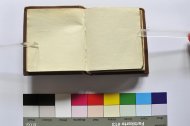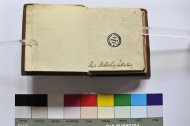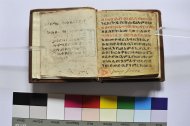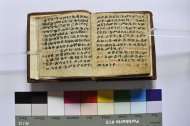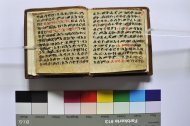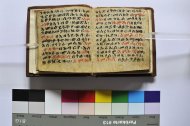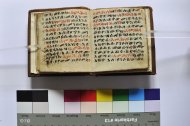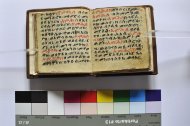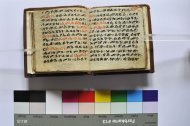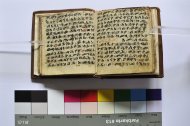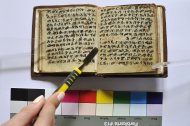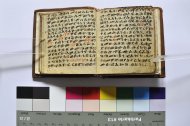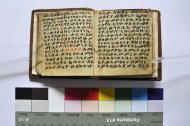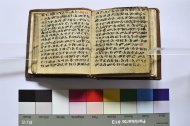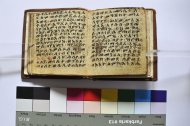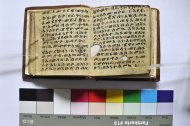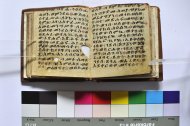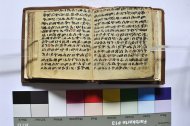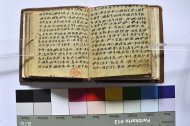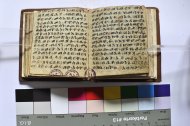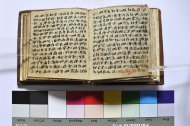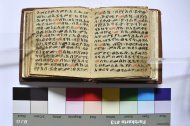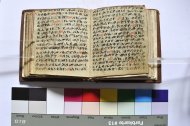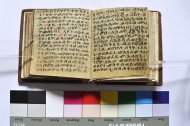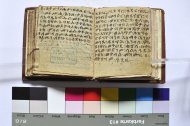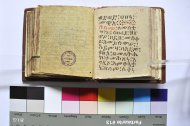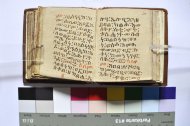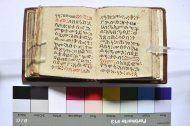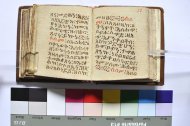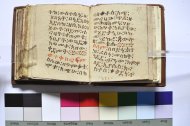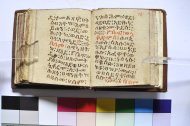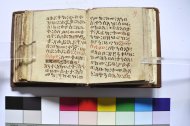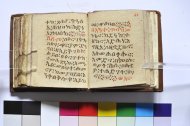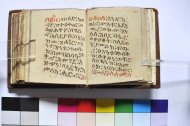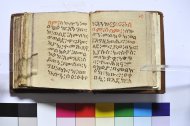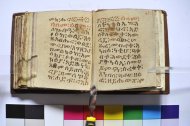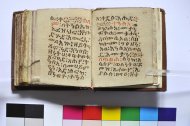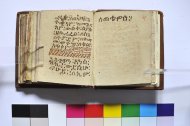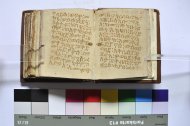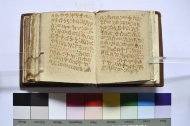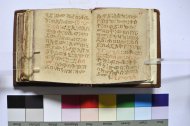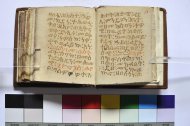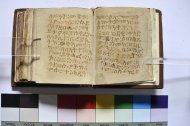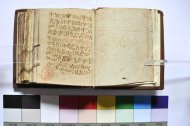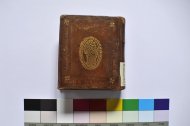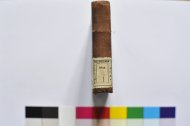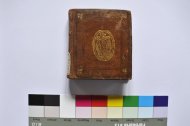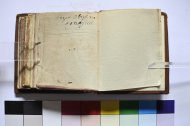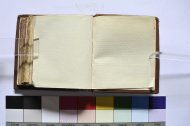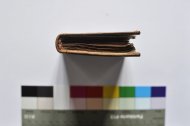|
Shelfmark |
R1 |
|
Inventory number |
– |
|
Owning institution |
Biblioteca Vallicelliana, Rome |
|
Typology |
Codex. The manuscript is composite: it consists of two codicological units, made in distinct times and materials and written by distinct hands: I (ff. 4–27, parchment), II (ff. 1–3, 28–52, paper). The two initial and two final paper guardleaves (ff. I–II, III–IV) have been added at a later stage, probably during the restoration that occurred in 1976. |
|
Title |
Preces Cantica et Orationes Ætiopica lingua scriptae |
|
Subject |
Liturgy, Hymns, Prayers, Apocrypha |
|
Language |
Gǝʿǝz |
|
Outer size (included the binding) |
96 x 85 x 22 mm |
|
Outer size of the textblock |
86 x 78 x 15 mm |
|
Number of folia |
I–II, 1–52, III–IV |
|
Binding |
European binding. Two cardboard boards covered with brown leather. The leather is decorated with blind tooled ornament and with golden ornament (Crucifixion on the front cover, Virgin and Child on the back cover, four lilies on the margins of both covers). Two small holes on the outer margin of both covers are most probably due to the early presence of closing laces. Red and white headband and tailband; six sewing stations. |
|
Sewing |
Modern linen thread |
|
Sewing pattern |
– |
|
Slip case |
– |
|
State of preservation of the binding |
Good. The manuscript was professionally restored in 1976 at the laboratory Santin, as evidenced by the stamp on the inner side of the back board. |
|
Provenance and history |
Unit I was owned by the French Orientalist Pierre Morin (1531–1603) and subsequently donated to the Congregation of the Oratory of Saint Philip Neri between 1602 and 1603–04. Later, it entered the Biblioteca Vallicelliana when the latter was established, in the mid-17th century. This is suggested by the ex-libris note “Petrus Morine” on f. 4r, possibly written by Morin himself or – less probably – by someone else shortly after Morin’s death. This manuscript might be one of the four books listed as “liber chaldaicus” in MS Roma, Bibl. Vallicelliana P 206, containing an inventory list of the book holdings possessed by Morin. At some point, at the latest in the 18th century, Unit II was added and bound together with the Unit I. According to the Latin note on f. 3r (note 2), the owner was a certain Ethiopian monk Zacharia, i.e. Zäkkaryas. Unit II was probably produced in Rome, since it is made of paper, a material support rarely used in Ethiopia in pre-modern times. In the mid-18th century, a Latin title was added on f. 2r by Vincenzo Vettori (1700–1782), Preposito of the Congregazione dell’Oratorio of Rome. |
Unit I (ff. 4–27)
|
Folia |
Ff. 4–27 |
|
Copying date |
15th – early 16th cent. |
|
Short description of the content |
Ff. 4r–26v: Ṣälotä zäʾǝgzǝʾǝtǝnä Maryam bädäbrä Golgota (“Prayer of Our Lady Mary on Mount Golgotha” to be read on 21st of Säne). Incipit: በስመ፡ አብ፡ … ጸሎት፡ ዘእግዝእትነ፡ ማርያም፡ ዘጸለየት፡ አመ፳ወ፩፡ ለወርኀ፡ ሰኔ፡ በደብረ፡ ጎልጎታ፡ ዝውእቱ፡ መቃብረ፡ እግዚእነ፡ ኢየሱስ፡ ክርስቶስ፡ እንዘ፡ ትብል፡ እግዚእየ፡ ወአምላኪየ፡ ኢየሱስ፡ ክርስቶስ። |
|
Writing material |
Goat parchment |
|
Blank folia |
– |
|
Quires |
3 |
|
Quire marks |
– |
|
Layout |
1 column |
|
Number of lines per column |
14 |
|
Ruling |
Blind ruling, from inside to outside. Executed irregularly. Blind pricking, executed from inside to outside. Most of the pricks have been cut out when the manuscript was trimmed. Lines are written above the ruling. |
|
Ruling pattern |
Nosnitsin 1 |
|
Scribe |
Unknown |
|
Colophon |
– |
|
Additional notes |
1. F. 4r: ownership note written in Latin in the lower margin, “Petrus Morine”. It refers to Pierre Morin, who owned this unit before entering the library. 2. F. 27r: short protective text, written in a contemporary hand to that of the main text and containing asmat (“magical names”) and directives. Incipit: ሂዳዛር፡ ሂዳዛር፡ ሂዳር፡ በጺሕ፡ ትነብር፡ በሣዕር፡ በጸናጽር፡ በአድባር፡ ወበደብር፡ ቈተላ፡ ዘባሕር፡ ትነብር፡ ዘቱረ፡. |
|
Decoration |
– |
|
Individuals mentioned in the MS |
Pierre Morin (1531–1603) is mentioned in note 1. |
|
State of preservation of the textblock |
Discrete.
|
Unit II (ff. 1–3, 28–52)
|
Folia |
Ff. 1–3, 28–52 |
|
Copying date |
18th century (?). |
|
Short description of the content |
Ff. 28r–44v: Mälkǝʾa ḥǝmamatä mäsqäl (“Mälkǝʾ-hymn to the Passion of the Cross”, Chaine nr. 25). The text is acephalous. It begins as follows: ብድብድ፡ ሀበነ፡ መዊአ። =። ሰላመ፡ ለመላቲ<ሒ>ከ፡ እደ<፡> ዕብራይ፡ ዘጸፍዖ፡ በዲበ፡ መስቀል፡ እመ<፡> ይሰውዖ። ኤዶምሃ፡ ለአዳም፡ ታብኦ፡ በመላትሒከ፡ ተመሕጸነ፡ እግዚኦ፡ Ff. 44v–45r: Incipit of a text The text contains only the first words of the incipit. The full text is: እዌጥን፡ አንሰ፡ ዝክረ፡ ውዳሴሁ፡ ርሁይ፡ (sic) ለኤዎ[45r]ስጣቴዎስ። Ff. 45v–51v: Sälam läṭǝntä gädlǝkä śännayä mäwiʾ wäfǝṣṣame (“Salutation to the beginning of your spiritual combat”, Hymn to St Giyorgis, Chaine nr. 195) Incipit: ሰላም፡ ለጥንተ፡ ገድልከ። ሰናየ፡ መዊእ፡ ወፍጻሜ። ጊዮርጊስ፡ ስመ፡ አበሜ። እንበለ፡ ይሕልፍ፡ መዕልተ፡ ወይትቍልቍል፡ ጸሐየ፡ ዕድሜ። ከመ፡ እቡን፡ እምሐይቅ፡ ሕግ፡ ሰርጸ፡ ጽጌ፡ ራደ፡ ቀሳሜ። |
|
Writing material |
Paper |
|
Blank folia |
1v, 2v, 27v, 52r |
|
Quires |
A + 3 (3 paper leaves sewn before unit I + 3) |
|
Quire marks |
– |
|
Layout |
1 column |
|
Number of lines per column |
13 |
|
Ruling |
No ruling. Blind pricking, executed from inside to outside. Most of the pricks have been cut out when the manuscript was trimmed. |
|
Ruling pattern |
– |
|
Scribe |
Unknown |
|
Colophon |
– |
|
Additional notes |
1. F. 1r: note written in black ink on the lower margin, indicating the owning institution: “R. Bibliotheca Vallicelliana”. 2. F. 3r: note written in Latin indicating the provenance of the book: “hunc librum accepi a fratre Zacharia Aethiope in Abyssinia”. The note was probably written in the 18th century. 3. F. 52v: note written in Italian in black ink indicating the language of the main text: “Lingua abissinica o etiopica”. |
|
Decoration |
– |
|
Individuals mentioned in the MS |
A certain Zacharia, an Ethiopian monk, is mentioned on f. 3r (note 2). |
|
State of preservation of the textblock |
Decent. |



